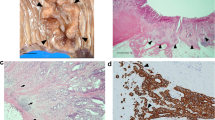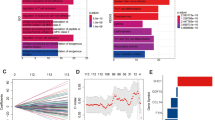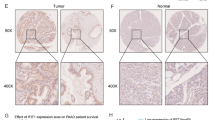Abstract
S100A11, one secreted protein, is overexpressed in certain cancers. We investigated S100A11 expression in various subtypes of lung cancer and explored its role in cell proliferation. S100A11 mRNA level was examined in 45 pairs of frozen lung cancer tissues by reverse transcriptase PCR (RT-PCR). The specific expression and subcellular distribution of S100A11 were examined in 78 paraffin-embedded lung cancers, 2 benign lung diseases as well as 22 healthy lung tissues by immunohistochemistry. S100A11 protein level was further analyzed in the sera of 86 lung cancer patients and 50 healthy individuals by enzyme-linked immunosorbent assay. We found that both mRNA and protein levels of S100A11 were overexpressed in adenocarcinomas (ADC) and squamous cell carcinomas (SCC) compared with paired non-cancerous lung tissues, while S100A11 was detected downregulated in small cell lung cancers (SCLC). Further immunohistochemistry staining was positive for S100A11 only in non-small cell lung cancer (NSCLC) (ADC, SCC, large cell carcinomas, et al.), but not SCLC. Conclusively, we found S100A11 protein level increased in the sera of NSCLC patients. Furthermore, when S100A11 expression was knocked down in lung adenocarcinoma cells A549 and LTEP-a-2, the cell proliferation was significantly inhibited in vitro and in vivo.







Similar content being viewed by others
Abbreviations
- SCC:
-
Squamous cell carcinoma
- ADC:
-
Adenocarcinoma
- SCLC:
-
Small cell lung cancer
- NSCLC:
-
Non-small cell lung cancer
References
Chen GA, Gharib TG, Wang H et al (2003) Protein profiles associated with survival in lung adenocarcinoma. PNAS 100:13537–13542
Granville CA, Dennis PA (2005) An overview of lung cancer genomics and proteomics. Am J Respir Cell Mol Biol 32:169–176
Todoroki H, Kobayashi R, Watanabe M et al (1991) Purification, characterization, and partial sequence analysis of a newly identified EF-hand type 13-kDa Ca(2+)-binding protein from smooth muscle and non-muscle tissues. J Biol Chem 266(28):18668–18673
Inada H, Naka M, Tanaka T et al (1999) Human S100A11 exhibits differential steady-state RNA levels in various tissues and a distinct subcellular localization. Biochem Biophys Res Commun 263:135–138
Torres-Cabala C, Panizo-Santos A, Krutzsch HC et al (2004) Differential expression of S100C in thyroid lesions. Int J Surg Pathol 12:107–115
Kanamori T, Takakura K, Mandai M et al (2004) Increased expression of calcium-binding protein S100 in human uterine smooth muscle tumours. Mol Hum Reprod 10:735–742
Ohuchida K, Mizumoto K, Ohhashi S et al (2006) S100A11, a putative tumor suppressor gene, is overexpressed in pancreatic carcinogenesis. Clin Cancer Res 12:5417–5422
Li N, Guo RF, Li WM et al (2006) A proteomic investigation into a human gastric cancer cell line BGC823 treated with diallyl trisulfide. Carcinogenesis 27:1222–1231
Rehman I, Azzouzi AR, Cross SS et al (2004) Dysregulated expression of S100A11 (calgizzarin) in prostate cancer and precursor lesions. Hum Pathol 35:1385–1391
Memon AA, Sorensen BS, Meldgaard P et al (2005) Down-regulation of S100C is associated with bladder cancer progression and poor survival. Clin Cancer Res 11(2 Pt 1):606–611
Tian T, Hao J, Xu AJ et al (2007) Determination of metastasis-associated proteins in non-small cell lung cancer by comparative proteomic analysis. Cancer Sci 98:1265–1274
Mountain CF (1997) Revisions in the international system for staging lung cancer. Chest 111:1710–1717
Conway TF, Sabel MS, Sugano M et al (2000) Growth of human tumor xenografts in SCID mice quantified using an immunoassay for tumor marker protein in serum. J Immunol Methods 233:57–65
Clark SP, Davis MA, Ryan TP et al (2007) Hepatic gene expression changes in mice associated with prolonged sublethal microcystin exposure. Toxicol Pathol 35:594–605
Cecil DL, Johnson K, Rediske J et al (2005) Inflammation-induced chondrocyte hypertrophy is driven by receptor for advanced glycation end products. J Immunol 175(12):8296–8302
Murzik U, Hemmerich P, Weidtkamp-peters S et al (2008) Rad54B targeting to DNA double-strand break repair sites requires complex formation with S100A11. Mol Biol Cell 19:2926–2935
Sakaguchi M, Miyazaki M, Inoue Y et al (2000) Relationship between contact inhibition and intranuclear S100C of normal human fibroblasts. J Cell Biol 149:1193–1206
Sakaguchi M, Sonegawa H, Murata H et al (2008) S100A11, an dual mediator for growth regulation of human keratinocytes. Mol Biol Cell 19:78–85
Acknowledgments
We thank Dr. Ligong Duan (General Administration of Sport) for providing the healthy control serum samples. We also thank Professor Jifu Liu and Dr. Shanshan Wu (the Department of Thoracic Surgery, General Hospital of Beijing Unit, PLA) for providing some tissues and lung cancer serum samples. This work was supported by National Basic Research Program of China Grants (No. 2010CB912203, No. 2011CB915504, and No. 2011CB710901).
Author information
Authors and Affiliations
Corresponding authors
Rights and permissions
About this article
Cite this article
Hao, J., Wang, K., Yue, Y. et al. Selective expression of S100A11 in lung cancer and its role in regulating proliferation of adenocarcinomas cells. Mol Cell Biochem 359, 323–332 (2012). https://doi.org/10.1007/s11010-011-1026-8
Received:
Accepted:
Published:
Issue Date:
DOI: https://doi.org/10.1007/s11010-011-1026-8




